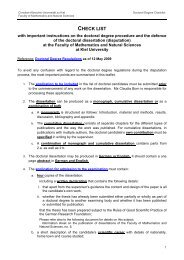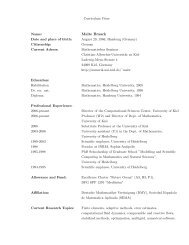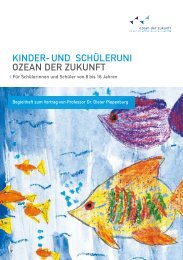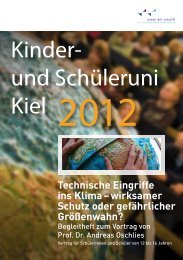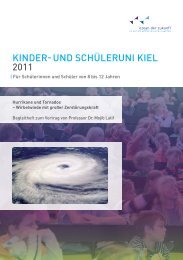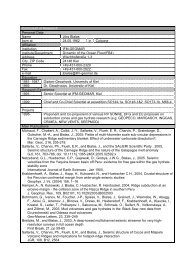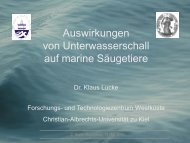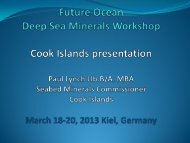Untitled - The Future Ocean
Untitled - The Future Ocean
Untitled - The Future Ocean
- No tags were found...
You also want an ePaper? Increase the reach of your titles
YUMPU automatically turns print PDFs into web optimized ePapers that Google loves.
mechanics, also with respect to dike stability, while J. Müller and U. Müller have addressed issuesof prehistoric and ancient disasters in coastal environments.4. ObjectivesIn 2005, the UN World Conference on Disaster Reduction called upon both natural and socialscientists all over the world to assist in the development and implementation of early warninginstruments and risk management tools. <strong>The</strong> proponents of B5(2) suggest, therefore, that a JRGshould adopt this challenge and address the full range of vulnerability issues in coastal zones bybuilding on the wide range of experiences in geographic, economic and social risk research in Kiel.With respect to future trends in the oceans (A2, A3, A4, A5, A7, B1, B4, B6 and, above all, B5(1)),these increasingly overlapping and interacting hazards call for innovative instruments forcomprehensive vulnerability assessments and integrated risk management. <strong>The</strong> objective of B5(2)can be reached by following a step-wise approach: (1) identification of the most crucial geographicrisk parameters for selected hazards by utilizing high-resolution remote sensing techniques; (2)integration of results into existing GIS-based models (e.g. flood inundation models, erosionmodels); (3) quantitative assessments of potential economic damages within the risk zone,covering both direct and indirect, tangible and intangible (e.g. ecological) values; subsequentincorporation into value-at-risk and related microeconomic models; (4) analysis of risk perceptionand awareness factors in societies with and without previous risk experiences; (5) utilization ofeconomic cost-benefit quantifications of risk mitigation strategies in order to develop a compositerisk valuation model; (6) adaptation of scenario-based techniques for fuzzy-set modeling ofdecision-making processes under uncertainty (Agent-Based Model, e.g. ABM, from the PotsdamInstitute for Climate Impact Research). <strong>The</strong> final product (model) may serve as a basic decisionsupporttool of the type recently requested by Munich Re and other insurance companies.With its focus on densely populated river mouths, B5(2) will have direct links to B5(1), where SLRrelatedchanges along the crucial interfaces will be detected, and to B4 for an analysis of tsunamipronelow-lying coastal regions (e.g. in Southeast Asia). For steps 5 and 6 the proponents andJRG will closely cooperate with Platform 1. <strong>The</strong> research of groups A4 (climate change), A7(economic valuing), and B6 (legal constraints) will also be of relevance to B5(2).5. ReferencesBoruff B, Emrich C, Cutter S (2005) Erosion Hazard Vulnerability of US Coastal Counties. Journalof Coastal Research 21, 932-942.Darwin RF, Tol RSJ (2001) Estimates of the Economic Effects of Sea Level Rise. Environmentaland Resource Economics 19 (2), 113-129.Dombrowsky WR, Ohlendieck L (1998) Flood management in Germany. In: Rosenthal UT, Hart P(Eds.): Flood Response and Crisis Management in Western Europe. A Comparative Analysis.Berlin, Heidelberg, New York, 153-187.Klein RJT, Nicholls RJ (1999) Assessing of Coastal Vulnerability to Climate Change. Ambio 28,182-187.85



